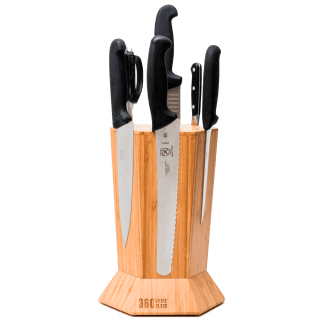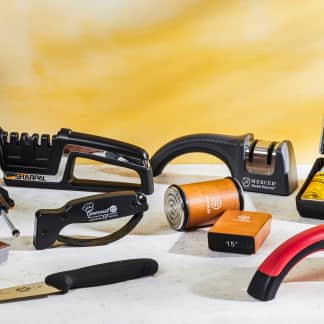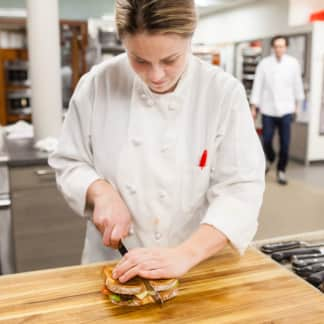Reviews You Can Trust.
See Why.
The Best Knife Block Sets
Nine pieces of matching cutlery, plus a block for easy storage? It could be a bargain—or a rip off.
Editor&aposs Note:Update, May 2024
We think most people are better off assembling their own knife sets. Check out our Test Kitchen à la carte Knife Set, which rounds up our top choices for all the most essential knives. We've also assembled a Best Buy à la carte Knife Set, a list of all our most budget-friendly favorites.
Top Picks

WinnerTest Kitchen à la carte Knife Set (7 pieces)

BEST BUYBest Buy à la carte Knife Set (7 pieces)
Sign up for the Well-Equipped Cook newsletter
Shop smarter with our ATK Reviews team's expert guides and recommendations.
What You Need to Know
We can’t help but be skeptical about knife block sets. As with cookware sets, their biggest selling point has always been the number of pieces the manufacturer can cram into the package, not the usefulness or quality of the blades themselves. Most collections are loaded not only with superfluous pieces but also with ones that are impractical or even useless. In the test kitchen, we’ve always maintained that there are just three truly essential knives: a chef’s knife, a paring knife, and a serrated (bread) knife. Beyond that, a boning knife, a slicing knife, and a good pair of kitchen shears can make certain tasks easier. But anything other than these six pieces is filler.
At the same time, we know that there are occasions (particularly during gift-giving season or when you’re outfitting a kitchen from scratch) when an attractive, all-in-one set of cutlery—complete with a block that keeps everything neatly housed and within easy reach—could be a nice convenience. Hoping to find that we’d been a bit hasty in our cynicism, we went shopping and returned to the test kitchen with eight knife block sets that contained anywhere from six to nine pieces and spanned a broad price spectrum: $97 all the way up to nearly $700. We would evaluate these sets against one another as well as against an à la carte selection of our test kitchen favorites. Our criteria would be as follows: how comfortable the pieces were to use and how well each performed; how many pieces in the collection were essential and how many extraneous; and of the extraneous stock, how much of it was actually useful. If the right package was out there, we’d gladly give it our stamp of approval.
The Big Three
The only way to assess the efficacy of a set was to put each piece through the paces. First, we singled out the core blades from each set—the chef’s, bread, and paring knives—and went about our everyday tasks. We diced onions, minced herbs, and broke down a whole chicken with each of the chef’s knives. We sliced large, crusty loaves and then diced soft Wonder bread with the serrated bread knives (the latter test would reveal the knives’ ability to make clean, precise cuts without squishing the food). We peeled, quartered, and cored apples with the paring knives. Later, we’d examine the other pieces to see if they offered any additional value to the set or if they simply took up space.
The good news was that all but one of the chef’s knives in the sets boasted our preferred length of 8 inches, and five out of the eight scored well. They were easy to handle and slipped effortlessly through food as we worked. The poorly performing specimens had a common flaw: Their blades were a little thicker than was ideal, and they tended to crush—rather than cleanly slice—onions and to bruise parsley as we minced.
The quality of the paring knives, however, was less impressive. Half of the blades were too wide or ungainly, which made the meticulous task of apple paring feel dicey. When we’d singled out the two we liked best, they turned out to be none other than our reigning favorite and our Best Buy, respectively. Two similar blades also fit our criteria, with slim, pointed, slightly flexible blades that measured 4 inches or less, providing added precision and control.
Meanwhile, blade length turned out to be the single most important—and detrimental—factor for the serrated bread knives. All were too short (8 or 9 inches) to saw a 10-inch-wide bread loaf into even slices. We wondered if manufacturers were including models shorter than the standard 10-inch size because a longer blade would stick out of the wooden block’s slots, but we were wrong: When we slid our favorite 10-inch model into the hole vacated by the 8-inch version included in the brand’s set, it fit completely. We figured—and more than one knife company executive admitted—that there was another reason for including shorter models: price. Smaller knives cost less to produce. Block sets are not compiled strictly according to their usefulness to consumers, they told us, but to meet price ceilings set by retailers, who want the maximum number of “pieces” in a block at an attractive price. (And by the way, the block itself always counts as one of the “pieces.”)
The Best (and Worst) of the Rest
Then came the other half of the equation: sorting through the extra pieces, the most common of which was a utility knife. “Utility” is an industry term for any blade bigger than a paring knife and smaller than a chef’s knife (usually measuring between 4½ and 6½ inches). We also found “sandwich,” “tomato,” and “citrus” knives and other single-task blades, all about the same size as the utility knives. Some were serrated and some weren’t, but all were too short to cut across larger pieces of fruit without sawing. While these medium-sized knives can be useful, we don't think they're as essential as some of our other favorites.
In fact, we found very few extra knives in any of the sets that weren’t somewhat redundant. Though the pointed-tipped carving knives included in two of the sets were perfectly functional, neither one did a better job cutting up roast beef or roast chicken than the chef’s knife already in these sets.
Most of the sets included honing or so-called sharpening steels. Though these metal rods don’t actually sharpen at all—they simply realign a bent cutting edge to make it straight again and more effective at cutting—they are useful tune-up devices. The only problem? With the exception of professional chefs, most people don’t know how to properly use the rods. (We didn’t deduct points for including steels, however.)
The only examples of truly useful extras in the sets were slicing knives, kitchen shears, and boning knives. In all but one set, the boning knives made removing small bones from raw meat and peeling away strips of tough silverskin easy. But most of the collections included flawed models of slicing knives and shears. One set came with a slightly too-short (10-inch) version of our favorite (12-inch) round-tipped slicing blade that peels off thinner, more uniform slices than a bulkier chef’s blade—and all the other models were way too short at 9 inches or less. One model was also disadvantageously sharp-tipped. (Pointed tips wedge into the meat, forcing you to saw back and forth to finish the task.) Four of the eight sets came with shears, but only one pair sported the long, super-sharp blades and comfortable handles that made cutting the backbone from a chicken feel effortless.
Not a Great Deal
In the end, our testing confirmed our suspicion that you are much better off shopping for knives à la carte; that way, you get only what you really need. If you must have a knife set, two sets contained well-constructed knives and more of the types that we found most useful. Because they also contain some knives that we didn’t find to be the best length or style, or that we found nonessential, we recommend them with reservations.
For your convenience, we've assembled a full list of Test Kitchen knife all-stars--and a great knife block to go with it. We also have a list of all our favorite inexpensive options so you can get the best on a budget.
America's Test KitchenWatch Now
Everything We Tested
Highly Recommended

WinnerTest Kitchen à la carte Knife Set (7 pieces)

BEST BUYBest Buy à la carte Knife Set (7 pieces)
Recommended with reservations
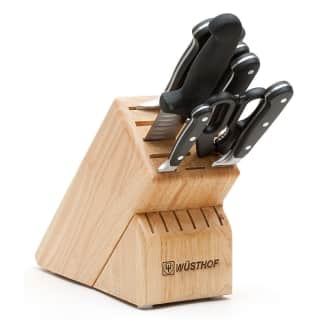
Wusthof Classic 8-Piece Deluxe Knife Set

Victorinox 7-Piece Rosewood Knife Set

Shun Classic 9-Piece Knife Set
Not Recommended

Messermeister Meridian Elite 9-Piece Knife Block Set

Global 9-Piece Knife Set
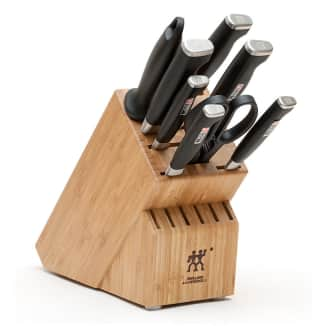
Zwilling J.A . Henckels Twin Four Star II Elite Knife Block Set, 9 Piece
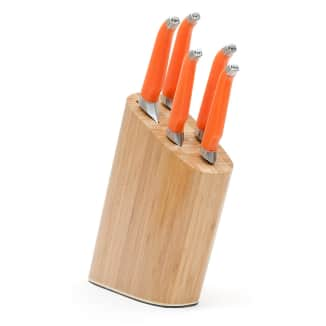
Rachael Ray Essentials 6-Piece Knife Block Set from Furi
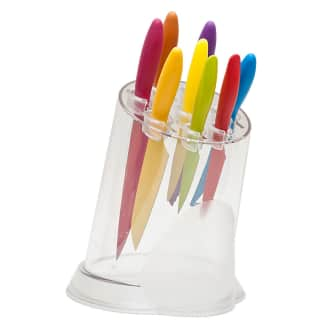
Pure Komachi II 9-Piece Knife Set in Clear Block
*All products reviewed by America’s Test Kitchen are independently chosen, researched, and reviewed by our editors. We buy products for testing at retail locations and do not accept unsolicited samples for testing. We list suggested sources for recommended products as a convenience to our readers but do not endorse specific retailers. When you choose to purchase our editorial recommendations from the links we provide, we may earn an affiliate commission. Prices are subject to change.

Reviews You Can Trust
The mission of America’s Test Kitchen Reviews is to find the best equipment and ingredients for the home cook through rigorous, hands-on testing. We stand behind our winners so much that we even put our seal of approval on them. Have a question or suggestion? Send us an email at atkreviews@americastestkitchen.com. We appreciate your feedback!
The Expert

byLisa McManus
Executive Editor, ATK Reviews
Lisa is an executive editor for ATK Reviews, cohost of Gear Heads on YouTube, and gadget expert on TV's America's Test Kitchen.
Lisa McManus is an executive editor for ATK Reviews, cohost of Gear Heads on YouTube, host of Cook's Illustrated's Equipment Review videos, and a cast member—the gadget expert—on TV's America's Test Kitchen. A passionate home cook, sometime waitress, and longtime journalist, she graduated from Columbia University's Graduate School of Journalism and worked at magazines and newspapers in New York and California before returning like a homing pigeon to New England. In 2006 she got her dream job at ATK reviewing kitchen equipment and ingredients and has been pretty thrilled about it ever since. Her favorite thing is to go somewhere new and find something good to eat.
Reviews You Can Trust.
See Why.

